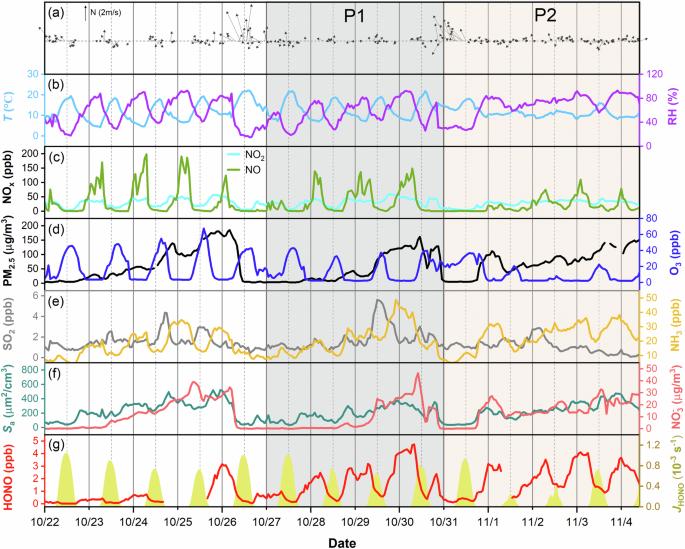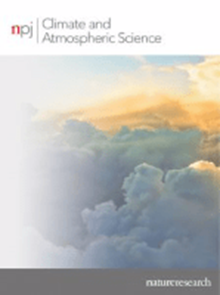北京秋季雾霾事件中相对湿度驱动的夜间 HONO 形成机制
IF 8.5
1区 地球科学
Q1 METEOROLOGY & ATMOSPHERIC SCIENCES
引用次数: 0
摘要
亚硝酸(HONO)是羟基自由基(OH)的主要前体,是影响大气化学和空气质量的因素之一。目前,提出的 HONO 来源还不能完全解释观测到的 HONO 浓度。本研究于 2021 年秋季在北京城区对 HONO 进行了全面的实地观测。使用默认主化学机制(MCM)的盒式模型无法再现观测到的 HONO 浓度,归一化平均偏差(NMB)为 -92.8%。在加入另外七种 HONO 形成途径后,NMB 降至-46.1%。根据观测数据计算了一些因子,如车辆排放因子(1.23%)和地面夜间二氧化氮异质吸收系数(8.25 × 10-6)。将夜间 NO2 异质转化的增强因子确定为相对湿度(RH)的函数,并将其纳入模型,从而补偿了缺失的夜间 HONO 源,并很好地还原了观测到的 HONO 浓度,NMB 为-5.1%。夜间 HONO 的主要来源是地表 NO2 的异相反应,占 85.6%。白天则是 NO 与 OH 的均相反应,占 41.8%。日间 OH 的主要来源是 HONO 的光解,占 73.6%,因此促进了二次污染物的形成,加剧了灰霾事件。本文章由计算机程序翻译,如有差异,请以英文原文为准。

Relative humidity driven nocturnal HONO formation mechanism in autumn haze events of Beijing
Nitrous acid (HONO), a key precursor of hydroxyl radicals (OH), is one of the factors affecting atmospheric chemistry and air quality. Currently, the proposed sources of HONO are not able to fully explain observed HONO concentrations. In this study, a comprehensive field observation of HONO was conducted in the autumn of 2021 in urban Beijing. The box model using a default Master Chemical Mechanism (MCM) was unable to reproduce the observed HONO concentrations with a normalized mean bias (NMB) of −92.8%. The NMB improved to −46.1% after the inclusion of seven additional HONO formation pathways. Several factors like vehicle emission factor (1.23%) and nocturnal NO2 heterogeneous uptake coefficient on the ground surface (8.25 × 10−6) were calculated based on observational data. The enhancement factor for nocturnal NO2 heterogeneous conversion was established as a function of relative humidity (RH) and incorporated into the model, which compensated for the missing nocturnal HONO sources and well-reproduced the observed HONO concentrations, with an NMB of −5.1%. The major source of HONO at night was found to be the heterogeneous reaction of NO2 on the ground surface, contributing up to 85.6%. During the daytime, it was the homogeneous reaction of NO with OH, accounting for 41.8%. The daytime primary source of OH was mainly the photolysis of HONO, which constituted 73.6% and therefore promoted the formation of secondary pollutants and exacerbated haze events.
求助全文
通过发布文献求助,成功后即可免费获取论文全文。
去求助
来源期刊

npj Climate and Atmospheric Science
Earth and Planetary Sciences-Atmospheric Science
CiteScore
8.80
自引率
3.30%
发文量
87
审稿时长
21 weeks
期刊介绍:
npj Climate and Atmospheric Science is an open-access journal encompassing the relevant physical, chemical, and biological aspects of atmospheric and climate science. The journal places particular emphasis on regional studies that unveil new insights into specific localities, including examinations of local atmospheric composition, such as aerosols.
The range of topics covered by the journal includes climate dynamics, climate variability, weather and climate prediction, climate change, ocean dynamics, weather extremes, air pollution, atmospheric chemistry (including aerosols), the hydrological cycle, and atmosphere–ocean and atmosphere–land interactions. The journal welcomes studies employing a diverse array of methods, including numerical and statistical modeling, the development and application of in situ observational techniques, remote sensing, and the development or evaluation of new reanalyses.
 求助内容:
求助内容: 应助结果提醒方式:
应助结果提醒方式:


